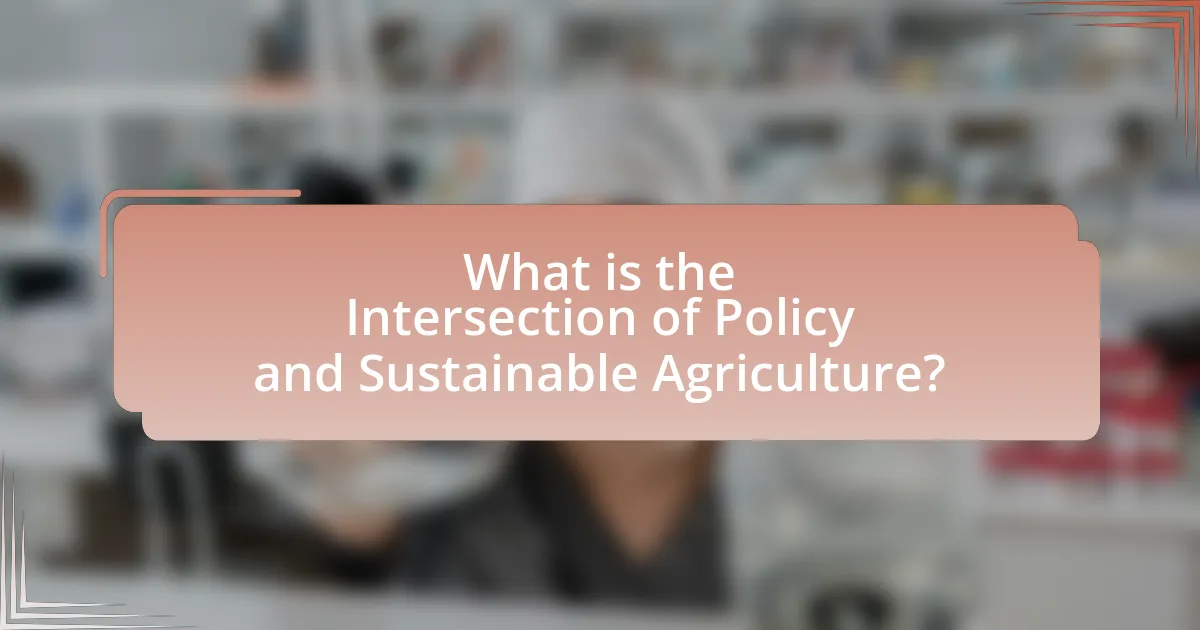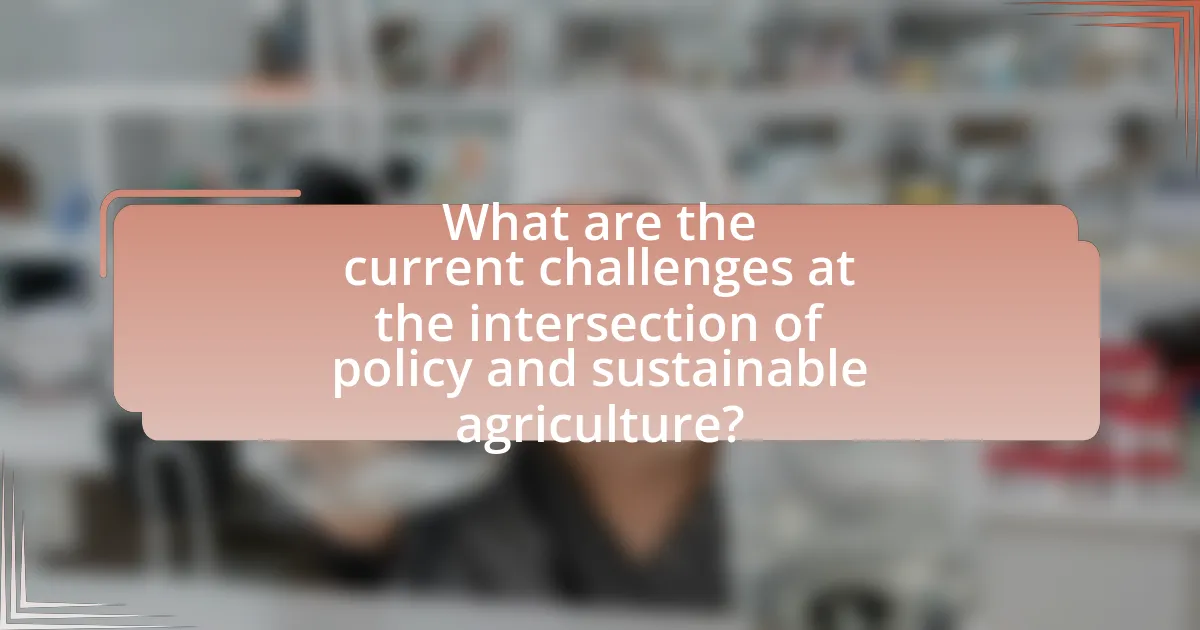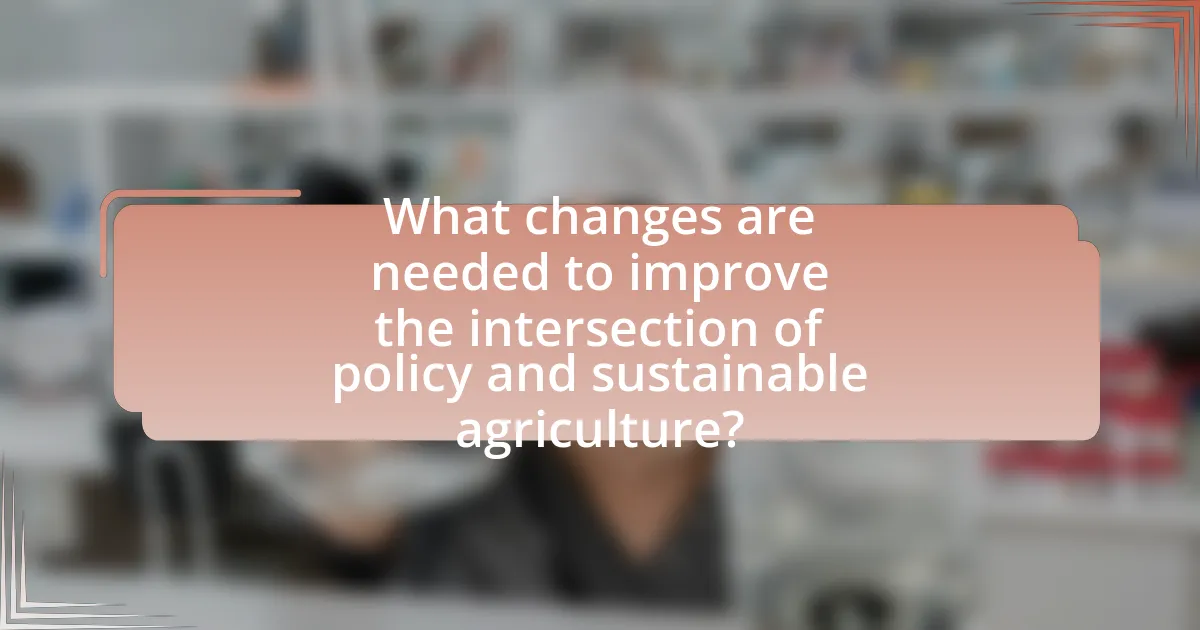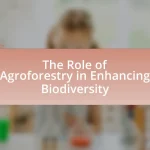The article examines the intersection of policy and sustainable agriculture, highlighting how regulations and guidelines can promote environmentally friendly farming practices while ensuring food security and economic viability. It discusses the influence of various policies, such as subsidies for organic farming and conservation programs, on sustainable agricultural practices and productivity. The article also addresses current challenges, including inadequate regulatory frameworks and economic barriers, and emphasizes the need for reforms that prioritize sustainability. Additionally, it explores the roles of stakeholders, including farmers, policymakers, and consumers, in advocating for effective policy changes to enhance agricultural sustainability.

What is the Intersection of Policy and Sustainable Agriculture?
The intersection of policy and sustainable agriculture involves the formulation and implementation of regulations and guidelines that promote environmentally friendly farming practices while ensuring food security and economic viability. Policies such as subsidies for organic farming, regulations on pesticide use, and incentives for conservation practices directly influence agricultural methods and sustainability outcomes. For instance, the 2018 Farm Bill in the United States allocated funding for conservation programs that support sustainable practices, demonstrating how policy can drive agricultural sustainability.
How do policies influence sustainable agricultural practices?
Policies significantly influence sustainable agricultural practices by establishing regulations, incentives, and frameworks that guide farming behaviors. For instance, government policies can promote sustainable practices through subsidies for organic farming, which encourage farmers to adopt environmentally friendly methods. Additionally, regulations that limit pesticide use or mandate crop rotation can directly impact farming techniques, leading to improved soil health and biodiversity. Evidence from the Food and Agriculture Organization indicates that countries with supportive agricultural policies see higher adoption rates of sustainable practices, demonstrating the critical role of policy in shaping agricultural sustainability.
What types of policies are currently in place for sustainable agriculture?
Current policies for sustainable agriculture include conservation programs, organic farming incentives, and regulations promoting environmentally friendly practices. For instance, the United States Department of Agriculture (USDA) administers the Conservation Stewardship Program, which encourages farmers to adopt practices that improve soil health and water quality. Additionally, the USDA’s Organic Certification Program supports organic farming by providing guidelines and financial assistance. These policies are designed to enhance agricultural sustainability by reducing environmental impact and promoting biodiversity.
How do these policies impact farmers and agricultural productivity?
These policies significantly impact farmers and agricultural productivity by shaping the economic environment in which they operate. For instance, subsidies can lower production costs, enabling farmers to invest in better technology and practices, which can enhance yield and sustainability. Conversely, restrictive regulations may limit farmers’ ability to adopt innovative practices, thereby hindering productivity. Research from the Food and Agriculture Organization indicates that countries with supportive agricultural policies experience higher productivity growth, demonstrating a direct correlation between policy frameworks and agricultural output.
Why is the intersection of policy and sustainable agriculture important?
The intersection of policy and sustainable agriculture is important because effective policies can promote environmentally friendly farming practices that enhance food security and protect natural resources. Policies that support sustainable agriculture can lead to reduced greenhouse gas emissions, improved soil health, and increased biodiversity. For instance, the Food and Agriculture Organization (FAO) emphasizes that integrating sustainable practices into agricultural policies can help mitigate climate change impacts while ensuring food production meets the needs of a growing population.
What are the environmental implications of agricultural policies?
Agricultural policies significantly impact the environment by influencing land use, water resources, and biodiversity. For instance, policies that promote monoculture can lead to soil degradation and reduced biodiversity, as seen in the widespread adoption of corn and soybean farming in the United States, which has resulted in a 30% decline in native plant species. Additionally, agricultural practices encouraged by certain policies can contribute to water pollution through runoff of fertilizers and pesticides, leading to dead zones in aquatic ecosystems, such as the Gulf of Mexico, where nutrient pollution has created an area of low oxygen that affects marine life. Furthermore, agricultural policies that favor intensive farming can exacerbate climate change by increasing greenhouse gas emissions, with agriculture accounting for approximately 10-12% of total emissions globally. These implications highlight the need for policies that promote sustainable practices to mitigate environmental harm.
How do policies affect food security and community health?
Policies significantly influence food security and community health by shaping access to resources, regulating food systems, and promoting sustainable practices. For instance, government policies that support local agriculture can enhance food availability and affordability, directly impacting food security. Research indicates that regions with supportive agricultural policies experience lower rates of food insecurity; for example, the USDA’s Economic Research Service reported that investments in local food systems can increase access to fresh produce, thereby improving community health outcomes. Additionally, policies that address nutrition education and food assistance programs contribute to healthier dietary choices, further linking policy decisions to the overall well-being of communities.

What are the current challenges at the intersection of policy and sustainable agriculture?
Current challenges at the intersection of policy and sustainable agriculture include inadequate regulatory frameworks, insufficient funding for sustainable practices, and conflicting agricultural policies that prioritize short-term productivity over long-term sustainability. For instance, many countries lack comprehensive policies that support agroecological practices, which are essential for enhancing biodiversity and soil health. Additionally, funding mechanisms often favor conventional farming methods, limiting the financial resources available for farmers transitioning to sustainable practices. Furthermore, policies may inadvertently promote monoculture and chemical inputs, undermining efforts to achieve sustainable agricultural systems. These challenges hinder the effective implementation of sustainable agriculture initiatives and the achievement of food security goals.
What barriers exist in implementing effective agricultural policies?
Barriers in implementing effective agricultural policies include inadequate funding, lack of stakeholder engagement, and insufficient data for decision-making. Inadequate funding limits the resources available for policy development and implementation, often resulting in poorly designed programs that fail to address the needs of farmers. Lack of stakeholder engagement, particularly from local farmers and communities, leads to policies that do not reflect on-the-ground realities, reducing their effectiveness. Additionally, insufficient data hampers the ability to assess agricultural needs and impacts, making it difficult to create evidence-based policies. For instance, a report by the Food and Agriculture Organization highlights that countries with limited agricultural data struggle to implement effective policies, leading to inefficiencies and missed opportunities for sustainable development.
How do economic factors hinder sustainable agricultural practices?
Economic factors hinder sustainable agricultural practices primarily through limited access to funding and resources. Farmers often face high initial costs for sustainable technologies and practices, such as organic farming or renewable energy systems, which can deter investment. For instance, a study by the Food and Agriculture Organization (FAO) indicates that smallholder farmers, who represent a significant portion of global agriculture, struggle to secure financing, with only 20% having access to credit. This lack of financial support restricts their ability to adopt sustainable methods that could improve productivity and environmental health. Additionally, market pressures often prioritize short-term profits over long-term sustainability, leading to practices that degrade soil and water resources.
What role does public awareness play in policy effectiveness?
Public awareness significantly enhances policy effectiveness by fostering informed public engagement and support for sustainable practices. When citizens are aware of agricultural policies and their implications, they are more likely to advocate for and adhere to these policies, leading to better implementation and outcomes. For instance, studies have shown that increased public knowledge about environmental issues can lead to greater participation in sustainability initiatives, as evidenced by the rise in community-supported agriculture programs and local food movements. This engagement not only strengthens policy adherence but also encourages policymakers to consider public input, ultimately resulting in more effective and responsive agricultural policies.
How do existing policies fail to support sustainable agriculture?
Existing policies often fail to support sustainable agriculture by prioritizing short-term economic gains over long-term environmental health. For instance, subsidies for conventional farming practices encourage the use of chemical fertilizers and pesticides, which degrade soil quality and harm biodiversity. According to a report by the Food and Agriculture Organization, approximately 30% of agricultural land is degraded due to unsustainable practices, highlighting the negative impact of current policies. Additionally, regulations may not incentivize practices such as crop rotation or organic farming, which are essential for maintaining ecological balance. This lack of support for sustainable methods ultimately undermines food security and environmental resilience.
What are the gaps in current agricultural legislation?
Current agricultural legislation has significant gaps, particularly in addressing climate change, biodiversity loss, and the needs of smallholder farmers. These gaps manifest in insufficient regulations that fail to promote sustainable practices, inadequate support for transitioning to eco-friendly farming methods, and a lack of comprehensive policies that integrate environmental health with agricultural productivity. For instance, the Food and Agriculture Organization (FAO) has highlighted that existing policies often prioritize industrial agriculture, neglecting the ecological impacts and the socio-economic challenges faced by smaller farms. Additionally, many countries lack robust frameworks for monitoring and enforcing sustainable practices, leading to inconsistent application of regulations.
How do these gaps affect farmers’ ability to adopt sustainable practices?
Gaps in policy and resource availability significantly hinder farmers’ ability to adopt sustainable practices. These gaps often manifest as insufficient financial support, lack of access to information, and inadequate infrastructure, which collectively create barriers to implementing environmentally friendly methods. For instance, a study by the Food and Agriculture Organization (FAO) highlights that farmers in regions with limited access to funding are less likely to invest in sustainable technologies, resulting in lower adoption rates of practices such as crop rotation and organic farming. Additionally, without proper training and resources, farmers may struggle to understand and implement sustainable practices effectively, further perpetuating reliance on conventional methods that may harm the environment.

What changes are needed to improve the intersection of policy and sustainable agriculture?
To improve the intersection of policy and sustainable agriculture, policies must prioritize environmental sustainability, incentivize regenerative practices, and enhance farmer education. Current agricultural policies often favor conventional methods that contribute to environmental degradation; therefore, integrating sustainability metrics into policy frameworks is essential. For instance, the 2018 Farm Bill in the United States included provisions for conservation programs, but expanding these to cover more sustainable practices can lead to better outcomes. Additionally, providing financial incentives for farmers who adopt sustainable practices, such as crop rotation and organic farming, can drive significant change. Research indicates that countries with supportive policies for sustainable agriculture see higher adoption rates of eco-friendly practices, leading to improved soil health and biodiversity.
What reforms can enhance policy support for sustainable agriculture?
Reforms that can enhance policy support for sustainable agriculture include implementing financial incentives for eco-friendly practices, establishing stricter regulations on harmful agricultural chemicals, and promoting research and development in sustainable farming technologies. Financial incentives, such as subsidies for organic farming, have been shown to increase adoption rates of sustainable practices, as evidenced by a study from the USDA which reported a 20% increase in organic farming participation following the introduction of such subsidies. Stricter regulations on pesticides and fertilizers can reduce environmental degradation, supported by findings from the European Commission indicating that countries with stringent regulations saw a 30% decrease in chemical runoff. Additionally, investing in research can lead to innovative solutions that improve crop yields while minimizing environmental impact, as highlighted by the Global Alliance for Climate-Smart Agriculture, which emphasizes the importance of research in achieving sustainable agricultural goals.
How can policies be designed to better incentivize sustainable practices?
Policies can be designed to better incentivize sustainable practices by implementing financial incentives, regulatory frameworks, and educational programs. Financial incentives, such as subsidies for sustainable farming techniques or tax breaks for environmentally friendly practices, encourage farmers to adopt methods that reduce environmental impact. Regulatory frameworks can establish standards for sustainable practices, ensuring compliance while promoting innovation in agricultural methods. Educational programs can raise awareness about the benefits of sustainability, equipping farmers with the knowledge and skills needed to implement these practices effectively. For instance, the European Union’s Common Agricultural Policy has integrated environmental measures that provide direct payments to farmers who adopt sustainable practices, demonstrating a successful model of policy design that incentivizes sustainability.
What role should government play in promoting sustainable agriculture?
The government should play a crucial role in promoting sustainable agriculture by implementing policies that incentivize environmentally friendly practices. This includes providing financial support, such as grants and subsidies, to farmers who adopt sustainable methods, which can lead to increased crop yields and reduced environmental impact. For instance, the U.S. Department of Agriculture’s Conservation Stewardship Program has allocated billions to support farmers in adopting practices that enhance soil health and biodiversity. Additionally, governments can establish regulations that limit harmful agricultural practices, ensuring that farming methods do not degrade natural resources. Research indicates that countries with strong agricultural policies focused on sustainability see improved food security and resilience against climate change, demonstrating the effectiveness of government intervention in this sector.
How can stakeholders collaborate to drive policy change?
Stakeholders can collaborate to drive policy change by forming coalitions that unite diverse interests, such as farmers, environmental groups, and policymakers. These coalitions can leverage collective expertise and resources to advocate for sustainable agricultural practices. For instance, the Food and Agriculture Organization (FAO) emphasizes the importance of multi-stakeholder partnerships in achieving sustainable development goals, highlighting that collaboration can lead to more effective policy outcomes. By sharing data, aligning goals, and engaging in dialogue, stakeholders can influence legislative processes and create policies that support sustainable agriculture initiatives.
What partnerships are essential for effective policy implementation?
Effective policy implementation requires partnerships between government agencies, non-governmental organizations (NGOs), private sector stakeholders, and local communities. These partnerships facilitate resource sharing, knowledge exchange, and collaborative problem-solving, which are crucial for addressing complex issues in sustainable agriculture. For instance, the Food and Agriculture Organization (FAO) emphasizes that multi-stakeholder partnerships enhance the effectiveness of agricultural policies by integrating diverse perspectives and expertise, leading to more comprehensive and sustainable solutions.
How can farmers, policymakers, and consumers work together for sustainability?
Farmers, policymakers, and consumers can work together for sustainability by establishing collaborative frameworks that promote sustainable agricultural practices, informed policy decisions, and responsible consumption. Farmers can adopt eco-friendly farming techniques, such as crop rotation and organic farming, which reduce environmental impact. Policymakers can create incentives for sustainable practices, such as subsidies for organic farming or regulations that limit harmful pesticides. Consumers can support sustainable agriculture by choosing locally sourced and organic products, thereby driving demand for environmentally friendly practices. Research indicates that integrated approaches involving all three stakeholders lead to improved sustainability outcomes, as seen in initiatives like the Sustainable Agriculture Research and Education program, which emphasizes collaboration among these groups to enhance agricultural sustainability.
What practical steps can be taken to advocate for policy changes in sustainable agriculture?
To advocate for policy changes in sustainable agriculture, stakeholders should engage in grassroots organizing, build coalitions, and utilize data-driven advocacy. Grassroots organizing involves mobilizing community members to raise awareness and influence local decision-makers, while building coalitions with farmers, environmental groups, and academic institutions can amplify voices and resources. Utilizing data-driven advocacy means presenting compelling evidence, such as the 2020 report from the Food and Agriculture Organization, which highlights that sustainable practices can increase crop yields by up to 30% while reducing environmental impact. These steps create a structured approach to influence policy effectively.


